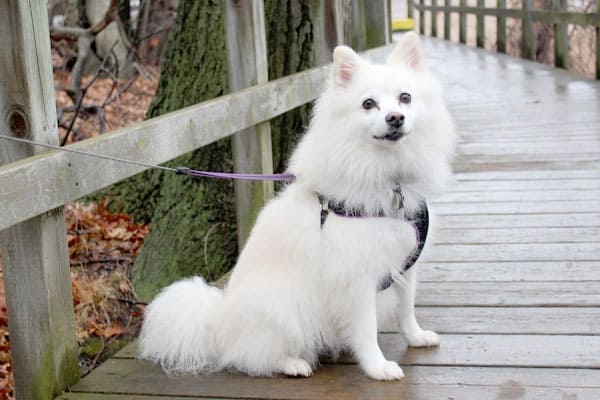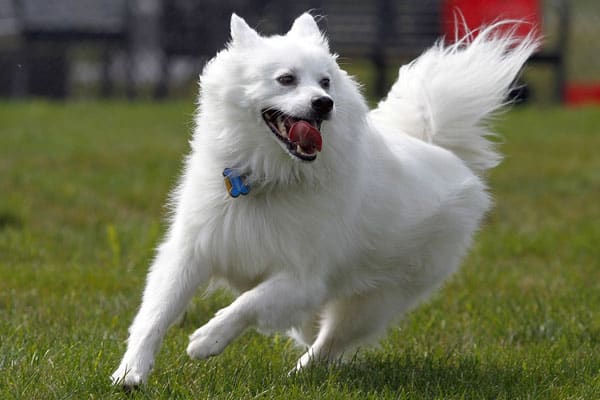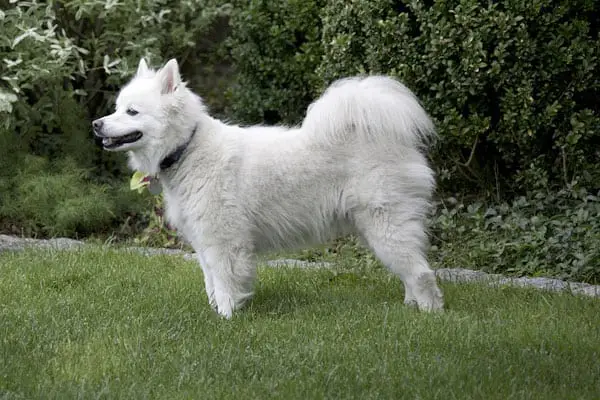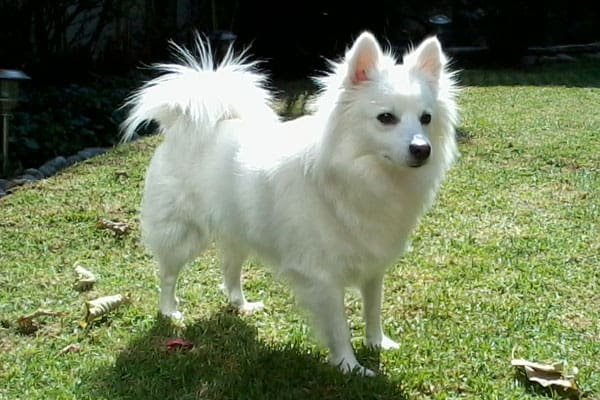Is American Eskimo Dog Hypoallergenic: Learn About This Dog’s Unique Coat Type

Today, the American Eskimo dog is bred in three sizes: toy, miniature, and standard. This dog breed will always look bigger than they are because of their thick, long, fluffy, and beautiful white coats.
However, if there is one thing the American Eskimo dog’s coat is not, it is hypoallergenic.
While there is a difference between the American Eskimo dog’s coat and the coats of many other purebred dog breeds, being hypoallergenic is not one of them.
This article reveals the truth about the American Eskimo dog’s lovely white coat.
Is American Eskimo Dog Hypoallergenic?
As the Mayo Clinic points out, the idea that any dog breed is hypoallergenic is a very popular myth, but a myth regardless.
When people use the word “hypoallergenic” to describe a dog breed, they mean “non-shedding.” These two terms are not interchangeable and do not mean the same thing, as we will discuss in much more detail here shortly.
Ultimately, the American Eskimo dog is a working dog breed that sheds a lot all year and even more seasonally. So this breed is the opposite of a non-shedding dog breed.
See An American Eskimo Dog’s Beautiful Coat
This adorable owner-made YouTube video showcases just how gorgeous the American Eskimo dog’s coat is right from puppyhood.
While the coat does change a great deal from puppyhood to the adult dog years, the appearance of the American Eskimo dog doesn’t change that much. They stay just as cute as they get bigger.
Why Do People Think Certain Dogs Are Hypoallergenic?
Many people still believe that some dog breeds are hypoallergenic because some dog breeds shed a lot less visibly than other dog breeds.
Take a Poodle, for example.
As the American Kennel Club (AKC) points out, this dog breed has a very dense and curly coat. The coat is so thick and curly that when hair sheds, it gets caught in the surrounding coat and doesn’t fall out visibly to the floor.
So people have taken to calling the Poodle a hypoallergenic (translation: non-shedding) dog breed.
However, the Poodle sheds just as much as the American Eskimo dog. The Poodle sheds, so if you don’t brush and groom a Poodle constantly, the shed hair trapped in the coat will turn into a massive tangle.
Then you will have to shave the Poodle to get rid of the tangle.
Because the American Eskimo dog sheds in a way that is easy to see, people understand right away that this dog is not hypoallergenic. But in truth, neither dog breed is hypoallergenic.
It is just that since the Poodle’s shed hair gets trapped in the surrounding coat, the person with the pet allergy may have slightly less contact with the protein that causes the pet allergies. But there is no guarantee of this.
What Causes Pet Allergies, Anyway?
Some people have pet allergies because they are sensitive to a specific protein allergen that pets make.
But the protein that causes some people to experience pet allergy symptoms is not made in the dog’s hair. It is found in the dog’s skin, saliva, and urine.
When the dog licks or grooms, urinates or sweats, the aggravating protein becomes onto the coat.
Once the protein allergen is on the hair, the person with the pet allergy can contact it by touching or handling the dog’s hair.
Common contact paths include patting the dog, cleaning up the shed, or dead hair.
And when you choose an American Eskimo dog, you will have a lot of shed, dead hair to clean up.
But ultimately, all dog breeds produce the same protein allergen, and all dogs can cause allergies in people who are sensitive to that protein.
What Makes the American Eskimo Dog’s Coat Special?
You might look at the gorgeous pure white fluffy American Eskimo and think the sheer beauty of the coat is unique enough.
But this working dog’s coat has several other unique properties; it is also fun to learn about.
To start with, the American Eskimo dog has a double-layer coat characteristic of most working dog breeds.
As VCA Hospitals explains, not only does this make the American Eskimo breed particularly cold-tolerant, but it also makes them somewhat heat-intolerant.
These dogs are descended from a long lineage of Arctic spitz working dogs that have historically been used to haul sleds and cargo, help with the hunt, serve as watchdogs and assist with herding and livestock protection.
So their thick, double-layer working-dog coats evolved to function very similarly to the warm winter coat you put on when it gets cold outside!
In addition, the American Eskimo dog’s coat layers have special features.
The outer layer is thicker, longer, coarser, and water-repellant. So when ice, snow, sleet, or rain hits the coat, it slides right off and doesn’t soak through to the skin, protecting the dog from cold and wetness.
The coat’s inner layer is soft, downy, and shorter – like insulation in a comforter. It is the final barrier between the elements, pests and perils, and the dog’s sensitive skin. The job of this layer is to keep the dog warm and dry.
How Much Does the American Eskimo Dog Shed?
As the American Kennel Club (AKC) breed profile page explains, American Eskimo dogs shed quite a bit yearly and seasonally.
But the seasonal sheds – an event that working dog owners have nicknamed “coat blows” – will really get your attention. With all that pure white hair, you may think you are in the middle of an actual snowstorm while it is happening.
So what happens during a coat blow, and why does it only occur seasonally?
The American Eskimo dog does indeed shed somewhat all year long. This is because the coat has an essential protective function, and as hairs wear out, they must be shed and replaced. Otherwise, the dog is vulnerable to the elements.
But seasonally, the shed becomes more intense.
Coat blow: cold season to warm-season
In the transition from the cold to the warm season, the dog will start to shed profusely to shed out the majority of that thick, dense, insulating inner layer – the layer designed to keep the dog warm.
With that inner layer in place, the American Eskimo dog is vulnerable to overheating during the warm season. So the dog needs to drop the coat quickly to avoid danger.
Coat blow: warm season to the cold season
In the transition from the warm season back to the cold season again, the coat blow may not seem quite so intense. The inner layer is busy growing back in.
Meanwhile, the outer layer is shedding and replenishing itself for the cold season.
How to Care for Your American Eskimo Dog’s Shedding Coat
Preventative Vet emphasizes the importance of choosing the right tools to brush and groom your dog at home.
You will need to do this frequently for a dog like the American Eskimo – at least if you want to avoid spending your valuable free time sweeping, wiping, and lint-rolling everything you own!
Vetstreet recommends following a basic at-home coat maintenance schedule of brushing your dog’s coat two to three times per week (more frequently during coat blow periods).
While the American Eskimo dog’s coat is not as prone to tangling and developing mats as some dog breeds, regular brushing will reduce the likelihood of this happening.
There are three particular dog grooming tools you will quickly learn you can’t live without the de-shedding rake, the stainless steel comb, and the bristle brush.
De-shedding rake
You can use a de-shedding rake to catch more dead, shed hair during each brushing session.
Many rakes catch the hair in the tines, and then you can press an “eject” button to push the trapped hair right into the trash can, so – no sweeping!
Stainless steel round-tip comb
Then you can use a stainless steel comb with round-tip tines to groom more sensitive or difficult-to-reach areas around the face and on the legs, tail, and hindquarters.
Bristle brush
A bristle brush with round-tip pins is an excellent choice to stimulate healthy circulation in the skin and help the coat to shine.
Bathing
While it is OK to bathe your American Eskimo dog every once in a while, this dog’s coat produces unique skin oils that help promote the water-resistant outer layer to do its job well.
So unless your dog rolls in something or becomes distinctly stinky, try to steer clear of too-frequent bathing that could strip the coat of those skin oils.
Can You Shave the American Eskimo Dog’s Coat?
Far too many American Eskimo dog owners have learned the hard way what happens when you try to shave a working dog breed’s protective double-layer coat.
You don’t ever want to do this!
The double-layer coat grows in two layers, from the puppy coat to the adult dog coat.
The underlayer grows as a uniform, thick, and insulating layer. Then the outer coarse and water-resistant guard hairs grow over the top.
From this point on, the coat will always retain its double-layer integrity, simply shedding out hairs as needed for coat maintenance and temperature control.
But once you shave the coat down to the skin, it will not grow back in the same manner ever again.
This is because the hair follicles will not receive the same message to grow in a particular pattern. Instead, the hairs will grow randomly, with the soft insulating inner layer hairs mingling and mixing with the outer coarse guard hairs.
Your dog will no longer have the complete protection of the coat. So now you will have the extra responsibility of ensuring your dog does not get sunburned, windburned, troubled by pests, damp or soaking wet, too hot, too cold….the list goes on and on.
Indeed, shaving your dog’s thick, shedding coat can initially appear to be an easy solution to lifelong issues of constantly brushing, grooming, sweeping, vacuuming, and de-linting everything in sight.
But if you genuinely do not have the time or inclination to do these chores, then an American Eskimo dog is not the right choice of dog breed.
In the same way, if you are very sensitive to shed pet hair and tend to come down with allergies, then an American Eskimo breed may not be the best pet choice for you.
Getting Your American Eskimo Dog Used to Brush and Grooming
You should plan to start brushing and grooming your dog right from puppyhood to be sure your dog grows up unafraid of these routine maintenance tasks.
It is wise to clip your dog’s nails, clean the ears, express the anal glands and brush the teeth simultaneously as you brush the coat, so your dog becomes comfortable with all these experiences.
Some American Eskimo dog owners will invest in professional grooming every few months to keep the coat trimmed and neat. But you can also learn to do this at home for a budget-friendly option.
Learning about the American Eskimo dog breed’s coat type is one of the best ways to decide if this is the right next companion canine for your family pet.


